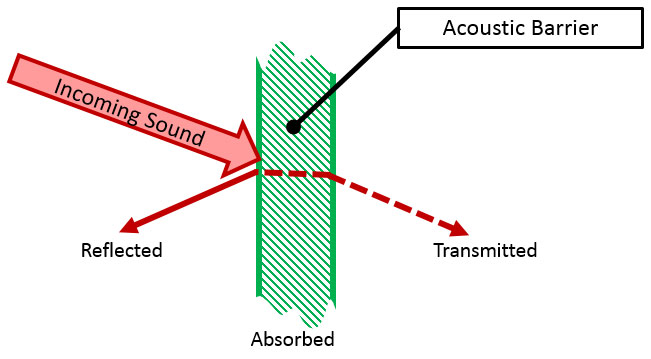acoustic absorption

Figure 1. Sound at a barrier can be absorbed, transmitted, or reflected.
Acoustic absorption is the loss or dissipation of sound energy in passing through a material or on striking a surface, usually through conversion to heat energy (Figure 1). The term may also refer to the property of a medium, material, or object to damp sound energy. That part of the sound striking a surface which is not absorbed is either reflected or transmitted.
The amount of absorption, reflection, and transmission of the sound is different for every frequency. For example, a high frequency sound with a short wavelength can be absorbed by a thinner piece of material, while lower frequency sounds are not absorbed, due to their longer wavelength.
The absorption process can be measured quantitatively and is of importance in the interior design of concert halls (see acoustics of buildings) and recording studios, etc. The unit used is the sabin: the metric sabin is the absorption power of 1 square meter of open window space (which reflects no sound and therefore is a perfect unit of absorption), the imperial unit is the absorption power of 1 square foot of open window space. The sabin is named after the American physicist William Clement Sabine who founded the field of architectural acoustics.
absorption coefficient
The absorption coefficient (α) is the fraction of energy which is absorbed on striking any surface = (absorbed acoustic energy)/(incident acoustic energy). It therefore takes values between 0 and 1, and usually depends on the frequency. In room acoustics, this coefficient is expressed as a fraction of the perfect absorption at an open window of equal area.
Factors that affect absorption include: material composition, thickness, and position, and humidity. Porous materials, such as cloth, foam, fiber glass, and acoustic tiles, typically absorb sound better than dense materials, such as concrete and glass.
| Absorption coefficient values | |
|---|---|
| material | absorption coefficient |
| fiber glass | 0.8–0.9 |
| acoustic tiles | 0.4–0.8 |
| hardwood | 0.3 |
| glass pane | 0.05–0.2 |
| concrete floor | 0.02 |


